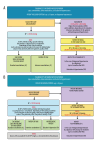The Critical Role of Community Pharmacists in Blood Pressure Monitoring
- PMID: 39143725
- PMCID: PMC11334671
- DOI: 10.12659/MSM.944657
The Critical Role of Community Pharmacists in Blood Pressure Monitoring
Abstract
Arterial hypertension is the most important modifiable risk factor for cardiovascular morbidity and mortality. In some countries, pharmacists' patient-centered approach has become a common practice, and their role in supporting the management of cardiovascular disease has been successfully developed for years. In particular, recent findings have confirmed benefits of pharmacist-provided hypertension care. Current guidelines emphasize the need for regular BP measurements in subjects age 40 years and older, who are at increased risk of hypertension. A panel of experts in cardiology, hypertensiology, family medicine, and pharmacy presented a narrative review of implementing community pharmacy blood pressure (CPBP) measurements into Polish pharmacy practice to assist pharmacists in CPBP readings. The paper focuses on basic aspects of management of untreated patients with elevated blood pressure levels, as well as management of individuals diagnosed with hypertension, who should follow their primary care physicians' recommendations for anti-hypertensive therapy. The article also includes a few important aspects related to CPBP measurement, such as equipment and techniques. Development of ready-made schemes of procedures for patients with different results of blood pressure measurement could ensure a uniform standard of services provided by pharmacists. This gives an opportunity to provide such patients with medical care and initiate treatment, and facilitates effective maintenance of BP in hypertensive subjects. This article reviews the role of pharmacists in Poland in screening for hypertension by taking blood pressure measurements.
Conflict of interest statement
Figures


References
-
- Visseren FLJ, Mach F, Smulders YM, et al. ESC National Cardiac Societies; ESC Scientific Document Group. 2021 ESC Guidelines on cardiovascular disease prevention in clinical practice. Eur Heart J. 2021;42(34):3227–37. - PubMed
-
- Mancia G, Kreutz R, Brunström M, et al. 2023 ESH Guidelines for the management of arterial hypertension The Task Force for the management of arterial hypertension of the European Society of Hypertension: Endorsed by the International Society of Hypertension (ISH) and the European Renal Association (ERA) J Hypertens. 2023;41(12):1874–2071. - PubMed
-
- World Health Organization. Global report on hypertension: The race against a silent killer. Geneva: 2023. Available from: https://www.who.int/publications/i/item/9789240081062.
-
- Stergiou GS, Palatini P, Parati G, et al. European Society of Hypertension Council and the European Society of Hypertension Working Group on Blood Pressure Monitoring and Cardiovascular Variability. 2021 European Society of Hypertension practice guidelines for office and out-of-office blood pressure measurement. J Hypertens. 2021;39(7):1293–302. - PubMed
Publication types
MeSH terms
LinkOut - more resources
Full Text Sources
Medical

